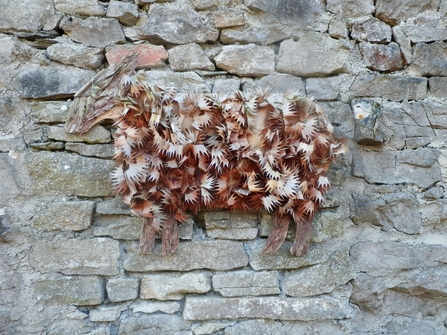
Wood shaving sheep by Charlie Whinney © Dyane Silvester
Join by 30 January to get 3 months free membership!

Wood shaving sheep by Charlie Whinney © Dyane Silvester
When we think of sculptures, all too often we imagine concrete or steel or sleek artificial materials – and many commercially available products are made from these but there are other options: some of my favourites are the amazing timber creations of chainsaw artists – of whom there are a few locally and who frequent shows and country markets around the county.
What better to do with a fallen tree than to create something beautiful on which moss and lichen can grow, giving insects a hiding (or hibernating) place? They typically have rough surfaces and nooks and crannies and hopefully aren't preserved using poisonous products. There's a company who create timber mushrooms along the same lines.
I'm intrigued by the possibilities of making sculptures from chicken-wire, and weaving natural materials – moss, twigs, or ferns – into them to encourage wildlife. If you have a dog, you could even weave its moulting fur into your chicken-wire sheep! The birds will thank you in the spring for the lovely nesting material; I frequently had “bearded sparrows” flying back and forth to their nests when I had a dog. Chicken wire has the great advantage of being durable and the sculptures largely hollow so you could even grow plants inside it; maybe herbs for pollinating insects. Where insects live, birds will come to feed too.
Out walking locally some while back, I passed a timber workshop with a sheep – made from wood shavings – on the wall outside. It struck me as a beautiful way to use waste; and just think of the insect-shelter potential!
Driftwood is one of my favourite things to work with – often you don't have to do anything with it except bring it home. You're walking on the beach and see a dragon or a peacock, but it's only a piece of wood and full of opportunity for providing shelter for insects in the garden. As it gradually decomposes you get worm-food (and if you're really lucky you might even attract a hedgehog) and free nutrients for the soil. In a few years you'll have the space back for a new creation.
My Mum carves branches and old tree stumps (they lost the fruit trees to honey fungus several years ago) into owls, gnomes, and even a blackbird and a woodpecker, but she has a talent – and patience – that I don't. Last winter her owl sheltered a hoard of hibernating ladybirds under its wing! She made us a heron to guard our pond, complete with woollen “plumage” and it was no time at all before it was colonised.
So if you're pondering a centrepiece for your patio or lawn, maybe think beyond the garden centre and see what you can create.